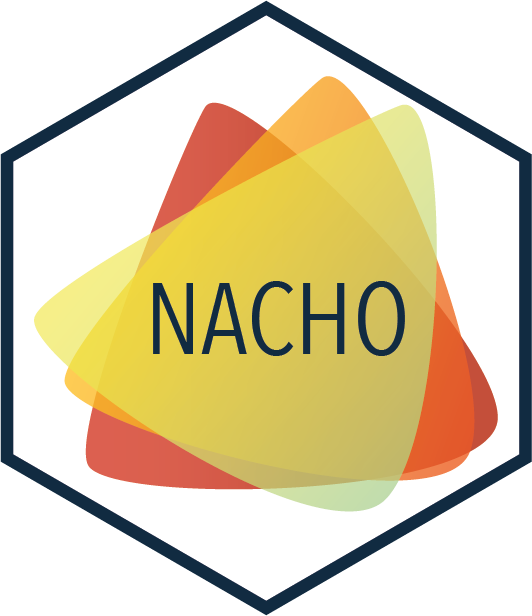NACHO Analysis
A NAnostring quality Control dasHbOard
Mickaël Canouil, Ph.D., Gerard A. Bouland and Roderick C. Slieker, Ph.D.
January 12, 2024
Source:vignettes/NACHO-analysis.Rmd
NACHO-analysis.Rmd
Installation
# Install NACHO from CRAN:
install.packages("NACHO")
# Or the the development version from GitHub:
# install.packages("remotes")
remotes::install_github("mcanouil/NACHO")Overview
NACHO (NAnostring quality
Control dasHbOard) is
developed for NanoString nCounter data.
NanoString nCounter data is a messenger-RNA/micro-RNA (mRNA/miRNA)
expression assay and works with fluorescent barcodes.
Each barcode is assigned a mRNA/miRNA, which can be counted after
bonding with its target.
As a result each count of a specific barcode represents the presence of
its target mRNA/miRNA.
NACHO is able to load, visualise and normalise the exported
NanoString nCounter data and facilitates the user in performing a
quality control.
NACHO does this by visualising quality control metrics,
expression of control genes, principal components and sample specific
size factors in an interactive web application.
With the use of two functions, RCC files are summarised and
visualised, namely: load_rcc() and
visualise().
- The
load_rcc()function is used to preprocess the data. - The
visualise()function initiates a Shiny-based dashboard that visualises all relevant QC plots.
NACHO also includes a function normalise(),
which (re)calculates sample specific size factors and normalises the
data.
- The
normalise()function creates a list in which your settings, the raw counts and normalised counts are stored.
In addition (since v0.6.0) NACHO includes two (three) additional functions:
- The
render()function renders a full quality-control report (HTML) based on the results of a call toload_rcc()ornormalise()(usingprint()in a Rmarkdown chunk). - The
autoplot()function draws any quality-control metrics fromvisualise()andrender().
For more vignette("NACHO") and
vignette("NACHO-analysis").
Canouil M, Bouland GA, Bonnefond A, Froguel P, Hart L, Slieker R (2019). “NACHO: an R package for quality control of NanoString nCounter data.” Bioinformatics. ISSN 1367-4803, doi:10.1093/bioinformatics/btz647.
@Article{,
title = {{NACHO}: an {R} package for quality control of {NanoString} {nCounter} data},
author = {Mickaël Canouil and Gerard A. Bouland and Amélie Bonnefond and Philippe Froguel and Leen Hart and Roderick Slieker},
journal = {Bioinformatics},
address = {Oxford, England},
year = {2019},
month = {aug},
issn = {1367-4803},
doi = {10.1093/bioinformatics/btz647},
}Analyse NanoString data
Load packages
library(NACHO)
library(GEOquery, quietly = TRUE, warn.conflicts = FALSE)
##
## Attaching package: 'BiocGenerics'
## The following object is masked from 'package:NACHO':
##
## normalize
## The following objects are masked from 'package:stats':
##
## IQR, mad, sd, var, xtabs
## The following objects are masked from 'package:base':
##
## anyDuplicated, aperm, append, as.data.frame, basename, cbind,
## colnames, dirname, do.call, duplicated, eval, evalq, Filter, Find,
## get, grep, grepl, intersect, is.unsorted, lapply, Map, mapply,
## match, mget, order, paste, pmax, pmax.int, pmin, pmin.int,
## Position, rank, rbind, Reduce, rownames, sapply, setdiff, sort,
## table, tapply, union, unique, unsplit, which.max, which.min
## Welcome to Bioconductor
##
## Vignettes contain introductory material; view with
## 'browseVignettes()'. To cite Bioconductor, see
## 'citation("Biobase")', and for packages 'citation("pkgname")'.
## Setting options('download.file.method.GEOquery'='auto')
## Setting options('GEOquery.inmemory.gpl'=FALSE)Download GSE70970 from GEO (or use your own data)
data_directory <- file.path(tempdir(), "GSE70970", "Data")
# Download data
gse <- getGEO("GSE70970")
## Found 1 file(s)
## GSE70970_series_matrix.txt.gz
getGEOSuppFiles(GEO = "GSE70970", baseDir = tempdir())
## size isdir
## /tmp/RtmpSTY7vk/GSE70970/GSE70970_RAW.tar 1986560 FALSE
## /tmp/RtmpSTY7vk/GSE70970/GSE70970_characteristics_readme.txt.gz 672 FALSE
## mode
## /tmp/RtmpSTY7vk/GSE70970/GSE70970_RAW.tar 644
## /tmp/RtmpSTY7vk/GSE70970/GSE70970_characteristics_readme.txt.gz 644
## mtime
## /tmp/RtmpSTY7vk/GSE70970/GSE70970_RAW.tar 2024-01-12 19:17:07
## /tmp/RtmpSTY7vk/GSE70970/GSE70970_characteristics_readme.txt.gz 2024-01-12 19:17:07
## ctime
## /tmp/RtmpSTY7vk/GSE70970/GSE70970_RAW.tar 2024-01-12 19:17:07
## /tmp/RtmpSTY7vk/GSE70970/GSE70970_characteristics_readme.txt.gz 2024-01-12 19:17:07
## atime
## /tmp/RtmpSTY7vk/GSE70970/GSE70970_RAW.tar 2024-01-12 19:17:06
## /tmp/RtmpSTY7vk/GSE70970/GSE70970_characteristics_readme.txt.gz 2024-01-12 19:17:07
## uid gid uname
## /tmp/RtmpSTY7vk/GSE70970/GSE70970_RAW.tar 1001 127 runner
## /tmp/RtmpSTY7vk/GSE70970/GSE70970_characteristics_readme.txt.gz 1001 127 runner
## grname
## /tmp/RtmpSTY7vk/GSE70970/GSE70970_RAW.tar docker
## /tmp/RtmpSTY7vk/GSE70970/GSE70970_characteristics_readme.txt.gz docker
# Unzip data
untar(
tarfile = file.path(tempdir(), "GSE70970", "GSE70970_RAW.tar"),
exdir = data_directory
)
# Get phenotypes and add IDs
targets <- pData(phenoData(gse[[1]]))
targets$IDFILE <- list.files(data_directory)Import RCC files
GSE70970 <- load_rcc(data_directory, targets, id_colname = "IDFILE")
## [NACHO] Importing RCC files.
## Error in load_rcc(data_directory, targets, id_colname = "IDFILE"): [NACHO] Multiple Nanostring file/software versions detected.
## Please provide a set of files with the same version.
## - FileVersion: '1.6', '1.6'
## - SoftwareVersion: '2.1.2.3', '2.1.1.0005'Perform the analyses using limma
library(limma)
##
## Attaching package: 'limma'
## The following object is masked from 'package:BiocGenerics':
##
## plotMAGet the phenotypes
selected_pheno <- GSE70970[["nacho"]][
j = lapply(unique(.SD), function(x) ifelse(x == "NA", NA, x)),
.SDcols = c("IDFILE", "age:ch1", "gender:ch1", "chemo:ch1", "disease.event:ch1")
]
## Error in eval(expr, envir, enclos): object 'GSE70970' not found
selected_pheno <- na.exclude(selected_pheno)
## Error in eval(expr, envir, enclos): object 'selected_pheno' not found## Error in eval(expr, envir, enclos): object 'selected_pheno' not foundGet the normalised counts
expr_counts <- GSE70970[["nacho"]][
i = grepl("Endogenous", CodeClass),
j = as.matrix(
dcast(.SD, Name ~ IDFILE, value.var = "Count_Norm"),
"Name"
),
.SDcols = c("IDFILE", "Name", "Count_Norm")
]
## Error in eval(expr, envir, enclos): object 'GSE70970' not found## Error in eval(expr, envir, enclos): object 'expr_counts' not foundAlternatively, "Accession" number is also available.
Select phenotypes and counts
- Make sure count matrix and phenotypes have the same samples
samples_kept <- intersect(selected_pheno[["IDFILE"]], colnames(expr_counts))
## Error in h(simpleError(msg, call)): error in evaluating the argument 'x' in selecting a method for function 'intersect': object 'selected_pheno' not found
expr_counts <- expr_counts[, samples_kept]
## Error in eval(expr, envir, enclos): object 'expr_counts' not found
selected_pheno <- selected_pheno[IDFILE %in% c(samples_kept)]
## Error in eval(expr, envir, enclos): object 'selected_pheno' not found- Build the numeric design matrix
design <- model.matrix(~ `disease.event:ch1`, selected_pheno)
## Error in eval(expr, envir, enclos): object 'selected_pheno' not foundlimma
Perform the analyses using lm (or any other model)
GSE70970[["nacho"]][
i = grepl("Endogenous", CodeClass),
j = lapply(unique(.SD), function(x) ifelse(x == "NA", NA, x)),
.SDcols = c(
"IDFILE", "Name", "Accession", "Count", "Count_Norm",
"age:ch1", "gender:ch1", "chemo:ch1", "disease.event:ch1"
)
][
Name %in% head(unique(Name), 10)
][
j = as.data.table(
coef(summary(lm(
formula = Count_Norm ~ `disease.event:ch1`,
data = na.exclude(.SD)
))),
"term"
),
by = c("Name", "Accession")
]
## Error in eval(expr, envir, enclos): object 'GSE70970' not found